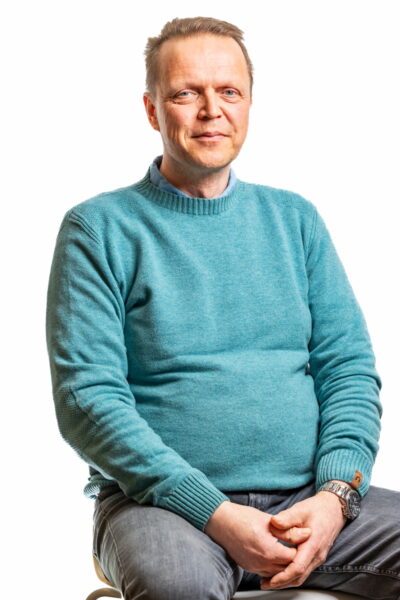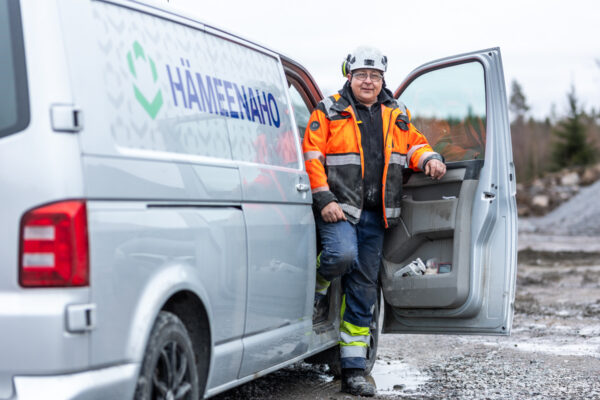
Ten years at the workshop created a good basis for Pasi’s new position
Pasi Vilmi started working at Hämeenaho in March 2014. He was placed at the workshop, and worked there for 10 years. During spring of 2024, Pasi’s gained a new job description at the machinery and spare parts acquisition at Hämeenaho. Pasi explains the work of an acquisition coordinator in practice and how the agility and values on responsibility of a family business are realised in acquisition of machinery and equipment.
When Pasi originally started his job, the Hämeenaho depot was just being built, so history repeats itself. At the time, the new depot created a new framework for the workshop operations. Now, as Hämeenaho continuously renews itself and its operations, Pasi is once again a part of creating new operating methods.
“I have a good starting point for my new work. With 10 years of experience, I know the equipment and machinery, and their current models and operating condition.”
“The core operations of my new job revolves around competitive tendering of the new equipment and machinery, and preparing acquisition for the order decision. I also draw subcontracts, observe prices of consumables and handle ordering once the decisions are made. Especially one of our big expense items, the price of fuel, is constantly being observed.”
Pasi admits that the work at the workshop was more clearly defined, but he would sometimes keep worrying about the work even at home. For Pasi, the current job is easier to leave at work.
“My commute to one direction is 70 kilometres. Once work is done, I can get the problems at work out of my head on my drive home.”
International acquisitions
Ten years and a daily commute of 140 kilometres are a testament of Pasi’s dedication towards his employee and work, and the scope of Hämeenaho operations ensure that there is enough work to go around.
“We have 120 to 14o machines in active use, ranging from forklifts and terminal tractors to big dump trucks. For extra-urban driving, we have hooked combined vehicles, trucks with a HIAB lift, carriages, and combined gravel vehicles for earth moving.”
Pasi’s acquisition work is aided by the existing network and good relationships to machine and equipment suppliers created during his years at the workshop.
“The brands of the machines we acquire have mainly stayed the same. An exception to this rule is made by our excavators, where we have acquired new brands for alternatives.”
The scope of Pasi’s acquisition work includes both used and new machinery, and the acquisitions come from all over Europe.
“Certain product are always acquired abroad, because we cannot get them from Finland. Especially used machines for earthworks and crushers and clipping machines are acquired abroad. For example, a new scrap clipping machine for by-product handling of the steel plant came from Portugal.”
However, new organisation related to Hämeenaho’s renewal does not mean that the agility of a family business is forgotten. In line with his responsibilities, Pasi levels and speeds the way of decision-making.
“I prepare the acquisitions for the different department supervisors and the board. I think this is a good system. The workshop spare parts’ acquisition has their existing channels. They make their daily acquisitions independently, so that even the smaller delays can be removed from the sudden needs.”
In practice, Pasi deals with the maintenance of fixed and mobile equipment. The needs always originate from the field. For example, one significant subject classified as spare parts is tyres, and the acquisition is always tendered.
Work and environmental responsibilities that go beyond requirements
Large portion of the acquired machinery are ready-to-use machines, but to increase safety at work, Hämeenaho makes independent adaptations based on the site or need. For example, the hot tolerance is increased for equipment that deal with molten steel and dross. For excavators, the cabin can be lifted or it can be equipped with more safety accessories.
“Normally, the machinery cabins are equipped with nets or grills, but we can also install an armoured glass to protect the operator of the machine.”
The next generation of the work machines is already realism. Fossil fuel powered machines are being replaced in accordance with equipment supply and demand.
“If the invitation for tenders calls for electric machines, then that is how they are tendered.”
In addition to environmental responsibility, the presumption is that electric machinery also provides other benefits.
“The predicted maintenance costs of electric machinery are lower than machines driven by a combustion engine.”
A lot is required from the Hämeenaho equipment, and in some case, they are operated 24/7. Are the replaced machines still usable when they are replaced?
“Yes. Most of them are sold for use when they are replaced. In some cases, we keep the older machine as a backup.”
In his current job, Pasi Vilmi is able to benefit his employee with all of the information, experience and machine and equipment supplier relationships he has gained, and those skills are needed in the sometimes though negotiations for the final machine price.
Pasi finds the energy for the negotiations and price discussions from outdoor hobbies and activities. Exercising with his dog, downhill skiing, mountain biking and taking care of his home and a cabin in Kainuu is quality time for Pasi Vilmi.

